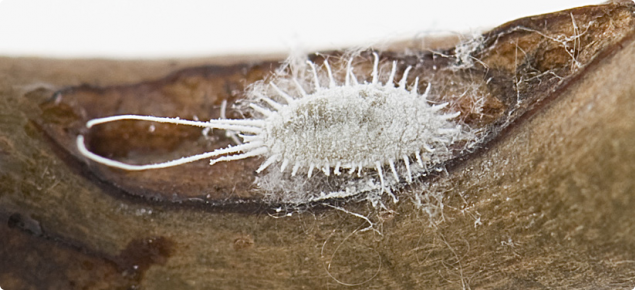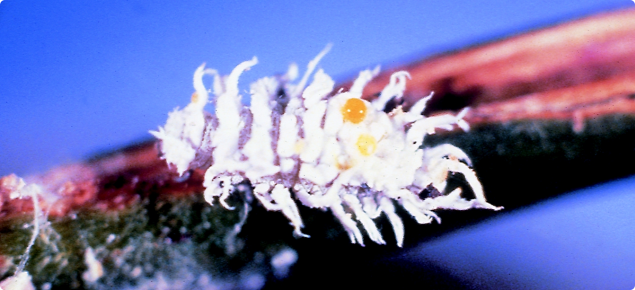Damage
- Mealybugs have piercing or sucking mouthparts that they insert into the plant to feed.
- Feeding weakens and stunts plants, causes leaf distortion and with spherical mealybug, shoots may twist if the infestation is heavy.
- Large quantities of honeydew are produced by mealybug, which can turn black with the growth of sooty mould fungus.
- Mealybugs can also hide under the calyx of the fruit, which can cause export problems.
Life cycle
- All mealybug species have a similar life cycle.
- Eggs are laid into an ovisac, an envelope made of silk enclosing the eggs or egg mass. The longtailed mealybug gives birth to live young.
- The young are free of wax, but appear similar to the adult female.
- Males have an additional pupal stage from which they emerge as delicate winged insects with long tail filaments. Seldom-observed, the adult male is a very weak flier and does not have a mouth to feed, dying within a few days of emerging.
Control
- In Western Australia, mealybugs were highly damaging to citrus in the early 1900s. Following the introduction of predatory beetles such as Cryptolaemus montrouzieri, populations have declined.
- Mealybugs are primarily managed by conserving their natural enemies and reducing ant populations.
- Treatment is rarely required and horticultural oil sprays are effective on young stages only. Mealybugs are less sensitive to petroleum spray oils than other citrus pests.
- Insecticides are also registered for mealybug control in citrus. As these recommendations can change, consult your nearest chemical reseller or the Australian Pesticides Veterinary Medicines Authority (APVMA) for more information.
Biological

Leptomastix wasp (mealybug parasite)
Parasites
Citrus mealybug
- Wasp parasites of citrus mealybug in Australia include Leptomastix dactylopii Howard, Anagyrus sp. (parasitises third instar), Leptomastidea abnormis (Girault) on second instar and Coccidoxenoides peregrina (Timberlake) on first instar. None is available commercially.
- Of these, Leptomastix dactylopii is considered to be the most useful mealybug parasite for control of citrus mealybug. The wasp (honey-coloured, 3mm long) parasitises third instar and young adult stages.
- It was released into Queensland from Brazil in 1980 and 1987, became established in Queensland and may occur in WA. It is not commercially available.
Longtailed and spherical mealybug
- In Australia, the wasp Anagyrus fusciventris (Girault) parasitises longtailed mealybug while spherical mealybugs are attacked by Anagyrus agraensis Saraswat. None of these species is commercially available.
Predators
Cryptolaemus larva are mealybug predators often mistaken for mealybugs
- Naturally occuring predators include lady beetles, lacewings and hoverfly larvae (Syrphids).
- An efficient predator of all three mealybug species is the mealybug ladybird, C. montrouzieri (pictured). Introduced from NSW to Western Australia in 1902, the adult and larvae feed on both larval and adult stages.
- Adults are black with a tan front end, 4mm long. Larvae grow to 1.3cm long and are covered with white waxy curls making it difficult to see their legs. The larvae resemble a mealybug, but are generally much larger. The wax can be scraped off to reveal the alligator-shaped beetle larva.
- C. montrouzieri eggs are yellow and are laid among the cottony egg sacks of mealybugs. Pupation occurs in sheltered places on stems or other substrate.
- Cryptolaemus can be purchased from a commercial insectary in early spring and released in orchards where citrus mealybugs were a problem the previous year. Release rates are around 1000 to 2000 beetles per hectare.
Citrus mealybug (Planococcus citris)

Citrus mealybug
- Most common and widely established mealybug in Western Australia.
- Though economic damage is rare, damage to fruit can occur if populations are high. Well-established infestations have all developmental stages present.
Identification
- Newly-hatched nymphs are light yellow and free of wax, but soon start to excrete a waxy cover.
- Immature males and all stages of the female are similar in appearance. The adult female is 3-4mm long. The filaments around the margins of the body are shorter than the filaments at the posterior end. There is a dorsal line (barely visible) running the length of the body.
- When squashed, the body fluid is yellow. Longtailed mealybug has pale yellow body fluid while spherical mealybug has purplish body fluid.
Life cycle
- Yellowish eggs are laid in an egg sac resembling a white cottony mass behind the female. Females can lay between 300-600 eggs and eggs take three to six days to hatch, depending on temperature.
- Life cycle duration (egg to egg-laying adult) can take up to three weeks, there are three to four overlapping generations per year.
- Male mealybugs live for two to four days after pupation. Adult females live for an average of 87.6 days as adults and can start laying eggs seven days into their adult life.
Longtailed mealybug (Pseudococcus longispinus)
Longtailed mealybug
- Found on citrus throughout Western Australia. Populations are usually low and no economic damage has been recorded by this species.
Identification
- Adult female 3-4mm long covered with a thin coating of white wax. Tail filaments are longer than, or as long as the body. Side filaments are also long compared to the other two species.
- Crawlers are pink, less than 1mm long. Later stages are similar in appearance to females.
- When squashed, the body fluid is pale yellow.
Life cycle
- Longtailed mealybugs do not produce an ovisac. Females either produce live young, or the eggs hatch into crawlers very quickly with females producing about 200 young.
- The longtailed generation time is longer than the citrus mealybug. Life cycle duration (egg to egg-laying adult) can take up to six weeks in summer and twice as long in winter.
Spherical mealybug (Nipaecoccus viridis)
The spherical mealybug
- In Western Australia, this species has only been found in Kununurra, and in Australia is recorded as a problem only in north Queensland. Worldwide, it is found in tropical and subtropical areas.
Description
- Adult female is 2.5-4 mm long, oval, slightly flattened in shape and covered with creamy white wax. Eggs and crawlers are purple.
- The body just visible under the wax is a purplish colour and body fluid is purple. The body of the female is usually almost hidden by the large white domed egg sac.
- Unlike other mealybugs, spherical mealybugs cluster in colonies on leaves and shoots.
Life cycle
- Eggs are laid in an egg sac which resembles a white, cottony, hemispherical mass behind the female. Females can lay up to 500 purplish eggs.
- In north Queensland at least six generations are produced a year.
Pink hibiscus mealybug (Maconellicoccus hirsutus)
Pink hibiscus mealybugs (Maconellicoccus hirsutus) and egg sacs on citrus
- In Western Australia, this species has only been found in Kununurra and is regarded to be a tropical species. In addition to citrus, it has been found on a wide range of hosts including capsicum, fig, hibiscus, grape, mango, squash and tomato.
Description
- Adult female is greyish-pink, 3 mm long and oval in shape.
- The body just visible under the wax is a pinkish-red colour and when crushed, the body fluids are pink.
- There are four stages including the crawler stage.
- Eggs are deposited in egg sacs which may be found on leaves, twigs, branches and fruit.



